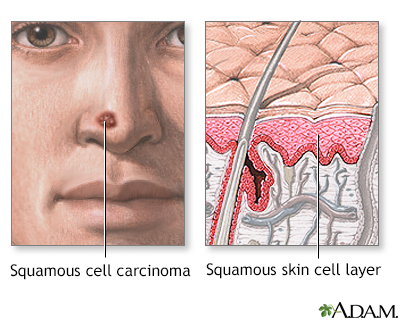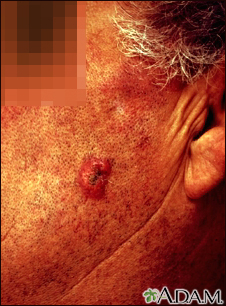Pregnancy SmartSiteTM
Cancer - skin - squamous cell; Skin cancer - squamous cell; Nonmelanoma skin cancer - squamous cell; NMSC - squamous cell; Squamous cell skin cancer; Squamous cell carcinoma of the skin DefinitionSquamous cell skin cancer is the second most common type of cancer in the United States. Other common types of skin cancer are: CausesSquamous cell skin cancer affects the epidermis, the top layer of skin. Squamous cell cancer may occur in undamaged skin. It can also occur in skin that has been injured or inflamed. Most squamous cell cancers occur on skin that is regularly exposed to sunlight or other ultraviolet radiation. The earliest form of squamous cell cancer is called Bowen disease (or squamous cell carcinoma in situ). This type does not spread to nearby tissues, because it is still in the outermost layer of the skin. Actinic keratosis is a precancerous skin lesion that may become a squamous cell cancer. A lesion is a problem area of the skin. A keratoacanthoma is a mild type of squamous cell cancer that grows rapidly. Risks of squamous cell cancer include:
SymptomsSquamous cell cancer usually occurs on the face, ears, neck, hands, or arms. It may occur in other areas. The main symptom is a growing bump that may have a rough, scaly surface and flat reddish patches. The earliest form (squamous cell carcinoma in situ) can appear as a scaly, crusted, and large reddish patch that can be larger than 1 inch (in) or 2.5 centimeters (cm). A sore that does not heal can be a sign of squamous cell cancer. Any change in an existing wart, mole, or other skin lesion could be a sign of skin cancer. Exams and TestsYour health care provider will check your skin and look at the size, shape, color, and texture of any suspicious areas. If your provider thinks you might have skin cancer, a piece of skin will be removed. This is called a skin biopsy. The sample is sent to a lab for examination under a microscope. A skin biopsy must be done to confirm squamous cell skin cancer or other skin cancers. TreatmentThe treatment depends on the size and location of the skin cancer, how far it has spread, and your overall health. Some squamous cell skin cancers may be more difficult to treat. Treatment may involve:
Support GroupsYou can ease the stress of illness by joining a cancer support group. Sharing with others who have common experiences and problems can help you not feel alone. Outlook (Prognosis)How well a person does depends on many things, including how soon the cancer was diagnosed, the location, and whether or not you have a weakened immune system. Most of these cancers are cured when treated early. Some squamous cell cancers may return. There is also a risk that squamous cell skin cancer may spread to other parts of the body. When to Contact a Medical ProfessionalContact your provider for an appointment if you have a sore or spot on your skin that changes in:
Also contact your provider if a spot becomes painful or swollen or if it starts to bleed or itch. PreventionExperts disagree about the value of routine skin exams by your provider. But all agree it's important to know your own skin and to contact your provider if you notice anything unusual. The best way to prevent skin cancer is to reduce your exposure to sunlight. Always use sunscreen:
Other measures to help you avoid too much sun exposure:
ReferencesAmerican Cancer Society website. How to do a skin self-exam. www.cancer.org/cancer/risk-prevention/sun-and-uv/skin-exams.html. Updated June 26, 2024. Accessed August 7, 2025. Dinulos JGH. Premalignant and malignant nonmelanoma skin tumors. In: Dinulos JGH, ed. Habif's Clinical Dermatology. 7th ed. Philadelphia, PA: Elsevier; 2021:chap 21. National Cancer Institute website. Skin cancer treatment (PDQ) - health professional version. www.cancer.gov/types/skin/hp/skin-treatment-pdq. Updated May 12, 2025. Accessed August 7, 2025. National Comprehensive Cancer Network website. NCCN Clinical Practice Guidelines in Oncology (NCCN Guidelines): Squamous cell skin cancer. Version 2.2025. www.nccn.org/professionals/physician_gls/pdf/squamous.pdf. Updated February 7, 2025. Accessed August 7, 2025. US Preventive Services Task Force, Mangione CM, Barry MJ, et al. Screening for skin cancer: US Preventive Services Task Force recommendation statement. JAMA. 2023;329(15):1290-1295. PMID: 37071089 pubmed.ncbi.nlm.nih.gov/37071089/. | ||
| ||
Review Date: 8/2/2025 Reviewed By: Ramin Fathi, MD, FAAD, Director, Phoenix Surgical Dermatology Group, Phoenix, AZ. Also reviewed by David C. Dugdale, MD, Medical Director, Brenda Conaway, Editorial Director, and the A.D.A.M. Editorial team. View References The information provided herein should not be used during any medical emergency or for the diagnosis or treatment of any medical condition. A licensed medical professional should be consulted for diagnosis and treatment of any and all medical conditions. Links to other sites are provided for information only -- they do not constitute endorsements of those other sites. No warranty of any kind, either expressed or implied, is made as to the accuracy, reliability, timeliness, or correctness of any translations made by a third-party service of the information provided herein into any other language. © 1997- A.D.A.M., a business unit of Ebix, Inc. Any duplication or distribution of the information contained herein is strictly prohibited. | ||


 Squamous cell canc...
Squamous cell canc... Sun protection
Sun protection Bowen's disease on...
Bowen's disease on... Keratoacanthoma
Keratoacanthoma Keratoacanthoma
Keratoacanthoma Skin cancer, squam...
Skin cancer, squam... Skin cancer - squa...
Skin cancer - squa... Squamous cell carc...
Squamous cell carc... Cheilitis - actini
Cheilitis - actini
